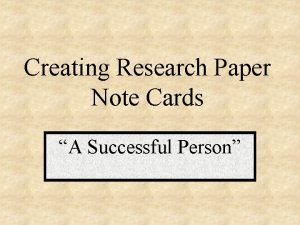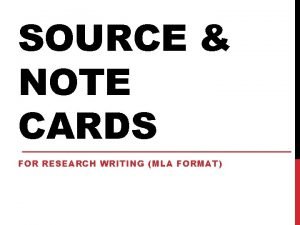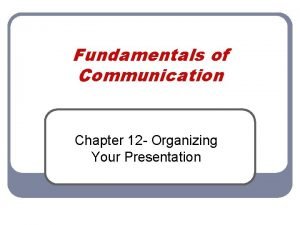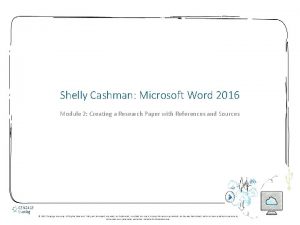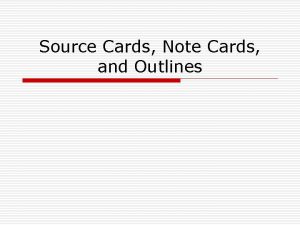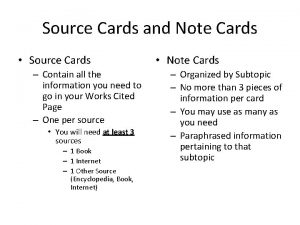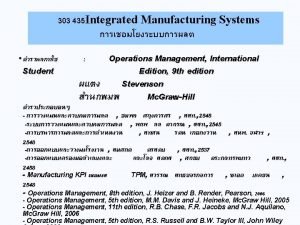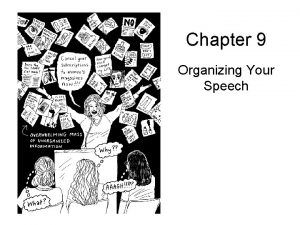Creating Note Cards Organizing Your Research Note Cards


















- Slides: 18

Creating Note Cards Organizing Your Research

Note Cards • • Now that you have chosen your topic and have found some resources, it is time to begin to read about your topic and begin taking notes. A note card is an organizational tool for the research process.

How to Make Note Cards • • Write on one side of the index card. You will need a note card for quotations, an author’s ideas, statistics, graphs, and charts. Make a separate note card for each idea or quotation you might want to use in your paper. Put quotation marks around material that is copied word for word.

Common Knowledge • If you find the same factual information in three or more sources, it is considered common knowledge and doesn’t require citation.

Beginning Research • In the early stages of research, it is going to be difficult to determine what is common knowledge. Therefore, if you write something down on a note card, give the source and page number so that you can track it down if needed.

Organizing Note Cards • MLA does not require a specific format for organizing note cards. However, the following format is mandatory for this class:

Sample Bibliography Card

Sample Bibliography Card Assign a number to each of your sources. Use proper MLA citations.

Sample Note Card

Sample Note Card Match the number to the corresponding bibliography card. Title the note card. Include only one major note per card. Specify if note is a summary, paraphrase, or quote.

What to Write • This can be a summary, a paraphrase, or a quotation from a book, a magazine article, an online database, or the Internet. This is the information that you will use to write your paper; in fact, you should be able to write your paper by using only your note cards and not have to refer back to the sources of information.

Citing Material • • • Quotations: direct quotes from your research. Paraphrasing: putting the ideas of others into your own words. Summarizing: giving the main idea, etc. of an author’s work.

Quotations • • • Put quotation marks around material that you copy word for word. When quoting a source that uses quotation marks, change the author’s double quotation marks to single quotation marks. According to Harold Bloom “‘the essence of The Great Gatsby is double vision’” (25).

Altering Quotes • If you are going to omit words or sentences from the quoted material, use ellipsis points. • Words – use 3 dots … • Sentences – use 4 dots …. • “Dickens was a keen observer of life…he showed sympathy for the poor” (Magill 27).

Fair Representation • • When you use an author’s work and alter quotes, paraphrase, or summarize, you must attempt to fairly represent the author’s point of view. It is poor scholarship to use an author’s work to imply that he represents a view that you would like him to represent rather than his own views. This also causes you to lose credibility.

Sample of Unfair Representation • Hilary Clinton writes, “it takes a village to raise a child” (Clinton 3). In this statement, Mrs. Clinton is advocating a retreat from urbanization and technology and a return to a premodern, agricultural society.

Summary • A summary captures the key ideas of an author in a few words. De. Young and Gilbert argue that the central mission of the Church is to proclaim the gospel rather than to alleviate the injustice of this world (De. Young and Gilbert 241).

Note Card Deadlines • First set of 20 -25 note cards January 21 • Bibliography cards • Second set of 20 -25 note cards January 21 January 28
 How to make source cards
How to make source cards Source cards for research paper
Source cards for research paper Quotation note card
Quotation note card Mla powerpoint citation
Mla powerpoint citation Bibliography cards definition
Bibliography cards definition What is source card
What is source card Note cards mla format
Note cards mla format Notecards for research paper
Notecards for research paper Cue cards for speech
Cue cards for speech Portfolio of evidence example
Portfolio of evidence example Organizing and outlining your speech
Organizing and outlining your speech Strategic order of main points
Strategic order of main points Amtobul example
Amtobul example Organizing an argument
Organizing an argument Organizing your argument
Organizing your argument Cengage word module 2 creating a research paper
Cengage word module 2 creating a research paper Declaration in writing
Declaration in writing Difference between note making and note taking
Difference between note making and note taking Signal phrases
Signal phrases

